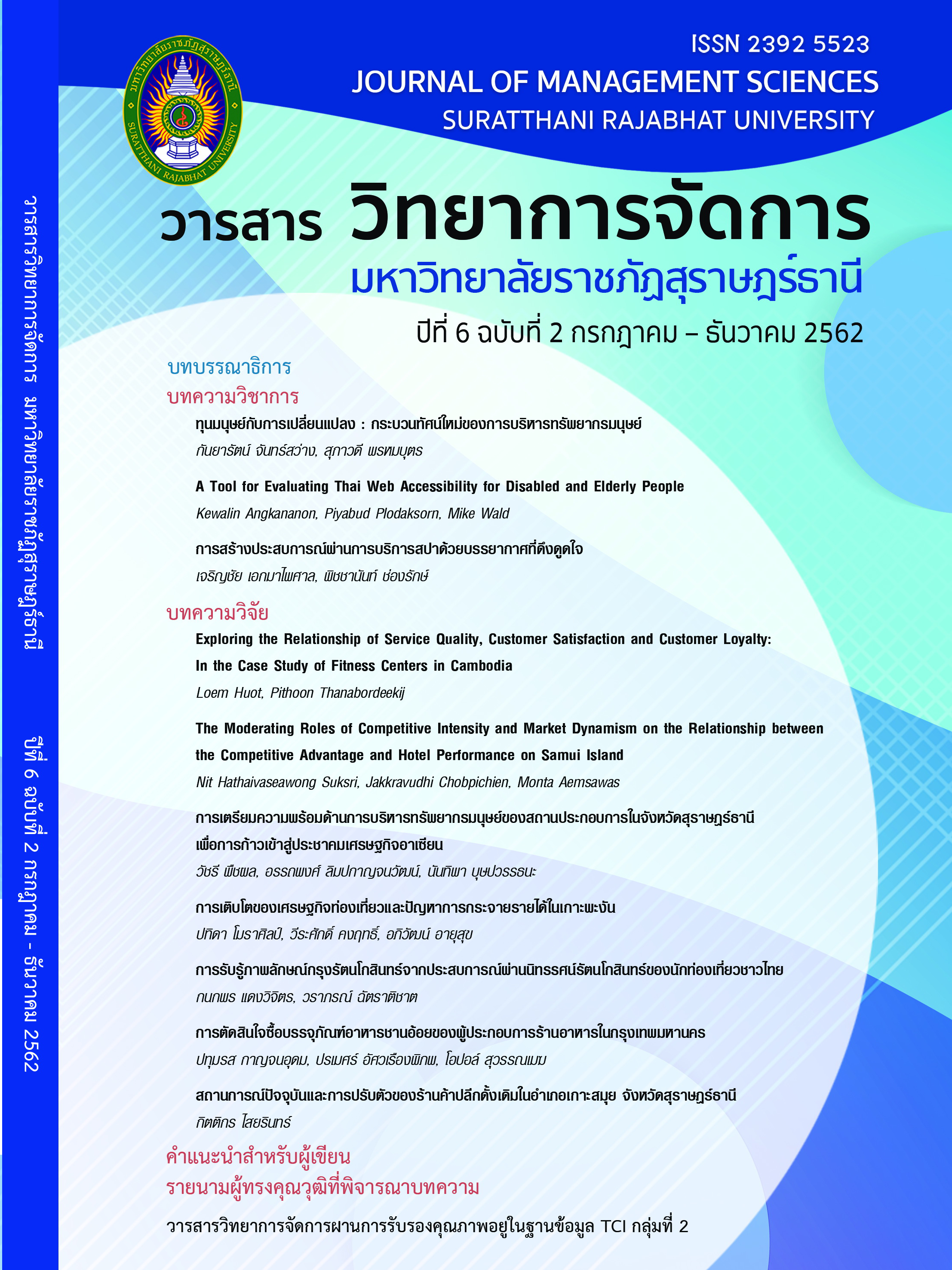Spa Goer Experience Design Through Atmospheric Cues
Main Article Content
Abstract
This article describes the importance and essence of creating an experience through spa customer service. A compelling atmosphere is one of the marketing tools that inflence the attitudes and behavior of spa goers. This article divides into three parts: the fist describes the overall operation of the spa and business in Thailand, the second presents the concept and elements of atmospheric cues, as a marketing tool, which is a fundamental importance in creating a spa experience. The last part summarizes and provides the recommendation for creating experiences for spa patrons by creating the right atmosphere. An essence to running a spa business is to create a remarkable,memorable and valuable experience, so this makes customers feel satisfid. In the competitive environment of today's spa business, creating value experiences is critical to success and a key driver for long - term business growth.
Article Details
References
สถาบันพัฒนาวิสาหกิจขนาดกลางและขนาดย่อม. (2557). ยุทธศาสตร์และแผนปฏิบัติการ ส่งเสริมวิสาหกิจขนาดกลางและขนาดย่อมรายสาขา. สืบค้นเมื่อ 30 ธันวาคม 2560. จาก http://www.sme.go.th/upload/mod_download/.
สุเนตรตรา จันทบุรี.(2559). โอกาสและความสามารถในการแข่งขันของธุรกิจสปาและนวดแผนไทย.วารสารเกษมบัณฑิต,17(2), 49 - 63.
Anuwichanont, J., & Mechinda, P. (2009). The Impact of Perceived Value on Spa Loyalty And Its Moderating Effect of Destination Equity. Journal of Business & Economics Research, 7(12),73 - 90.
Azman, I., & Chan, K. (2010). Health and spa tourism business: Tourists’ profies and motivational factors. Health, Wellness and Tourism: healthy tourists, healthy business, 9(24).
Baker, J., Grewal, D., & Parasuraman, A. (1994). The inflence of store environment on quality inferences and store image. Journal of the Academy of Marketing Science, 22(4), 328 - 339.
Banyan Tree Hotels and Resorts. (2017). Signature treatment. Retrieved 30 Dec 2017. From http://www.banyantree.com/spa/signaturetreatment.
Berry, L. L., Carbone, L. P., & Haeckel, S. H. (2002). Managing the total customer experience.MIT Sloan management review, 43(3), 85.
Bjurstam, A., & Cohen, M. (2010). Spas and the future leadership climate. In Cohen, M. & Bodeker,G. (Ed.), Understanding the global spa industry (pp. 363 - 376). Burlington: Routledge.
Carù, A., & Cova, B. (2003). Revisiting consumption experience: A more humble but complete view of the concept. Marketing theory, 3(2), 267 - 286.
Chieochankitkan, A. (2013). Developing service quality for spa establishments in the active beach tourism cluster, Thailand. Doctoral thesis, Graduate School of Tourism Management,National Institute of Development Administration.
Chivasom (2017). Picture Gallery. Retrieved December 30, 2017. From http://www.chivasom.com/the-resorts/hua-hin-thailand/picture-gallery/.
Cohen, M. (2008). Spas, wellness and human evolution. In Cohen, M. & Bodeker, G. (Ed.),Understanding the global spa industry (pp. 3 - 25). Burlington: Routledge
Dixit, S. K. (Ed.). (2017). The Routledge Handbook of Consumer Behavior in Hospitality and Tourism.New York: Routledge.
Donovan, R. J., & Rossiter, J. R. (1982). Store Atmosphere: An Environmental Psychology Approach.Journal of retailing, 58(1), 34.
Elias-Almeida, A., Miranda, F. J., & Almeida, P. (2016). Customer delight: perception of hotel spa consumers. European Journal of Tourism, Hospitality and Recreation,7(1), 13 - 20.
Evans, J. R., & Berman, B. (1997). Marketing (7th ed.). UpperSaddle River, NJ: Prentice Hall.
Frost, G. J. (2004). The spa as a model of an optimal healing environment. Journal of Alternative &Complementary Medicine, 10(1), 85 - 92.
Hoffman, K. D., & Turley, L. W. (2002). Atmospherics, Service Encounters and Consumer Decision Making: An Integrative Perspective. Journal of Marketing Theory and Practice, 10(3), 33 - 47.doi: 10.1080/10696679.2002.11501918.
ISPA. (2012). Experience ISPA-International Spa Association. Retrieved July 8, 2017. From http://www.experienceispa.com/about-ispa/.
ISPA. (2016). Spa-goers: Types of spas. RetrievedJuly 8, 2017. From http://www.experienceispa.com/about-ispa/.
Kang, E., Boger, C. A., Back, K.-J., Madera, J. (2011, January). The impact of sensory environments on Spagoers’ emotion and behavioral intention. 16th Graduate Students Research Conference. Retrieved December 23, 2017. From http://scholarworks.umass.edu/gradconf_hospitality/2011/Presentation/77/ Google Scholar.
Kogiso, K. (2012). Thai Massage and health tourism in Thailand: tourism acculturation process of “Thai Massage”. International Journal of Sport and Health Science, 10, 65 - 70.
Kotler, P. (1973). Atmospherics as a marketing tool. Journal of retailing, 49(4), 48 - 64.
Lagrosen, Y., & Lagrosen, S. (2016). Customer perceptions of quality–a study in the SPA industry. European Business Review, 28(6), 657 - 675.
Lo, A. S., & Wu, C. (2014). Effect of Consumption Emotion on Hotel and Resort Spa Experience.Journal of Travel & Tourism Marketing, 31(8), 958 - 984. doi: 10.1080/10548408.2014.895692.
Loureiro, S. M. C., Almeida, M., & Rita, P. (2013). The effect of atmospheric cues and involvement on pleasure and relaxation: The spa hotel context. International Journal of Hospitality Management, 35, 35 - 43. https://doi.org/10.1016/j.ijhm.2013.04.011.
Marriott International. (2017). Spa Vinothérapie Caudalie Marqués de Riscal. Retrieved December 30, 2017. From http://www.spamarquesderiscal.com/.
Ngamsirijit, W. (2016). From Spa to Wellness: Jirung’s Intellectual Capital Strategy. NIDA Case Research Journal, 8(2), 1 - 24.
Pradeep, A. (2010). The Buying Brain: Secrets for Selling to the Subconscious Mind. New Jersey:Wiley.
Puczkó, L., & Bachvarov, M. (2006). Spa, Bath, Thermae: What's Behind the Labels? Tourism Recreation Research, 31(1), 83 - 91. doi: 10.1080/02508281.2006.11081250.
Smith, M., & Puczkó, L. (2014). Health, tourism and hospitality: Spas, wellness and medical travel.(2rd ed.). New York: Routledge.
Somkeatkun, W., & Wongsurawat, W. (2017). Perceptions of the Spa Industry: An Importance Performance Analysis. Journal of Quality Assurance inHospitality and Tourism, 18(4),416 - 436. https://doi.org/10.1080/1528008X.2016.1250241.
Turley, L. W., & Milliman, R. E. (2000). Atmospheric effects on shopping behavior: a review of the experimental evidence. Journal of Business Research, 49(2), 193 - 211.
Verhoef, P. C., Lemon, K. N., Parasuraman, A., Roggeveen, A., Tsiros, M., & Schlesinger, L. A.(2009). Customer experience creation: Determinants, dynamics and management strategies. Journal of retailing, 85(1), 31 - 41.
Walton, J. K. (2012). Health, sociability, politics and culture. Spas in history, spas and history:an overview. Journal of Tourism History, 4(1), 1 - 14. doi: 10.1080/1755182X.2012.671372.Ziraspa (2017). Zira Spa The Secret of Lanna. Retrieved December 30, 2017. From http://ziraspa.com/.


